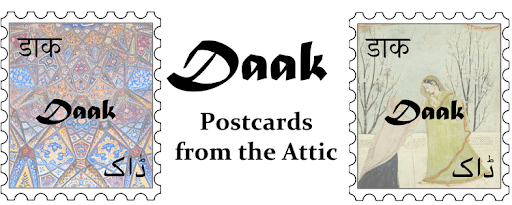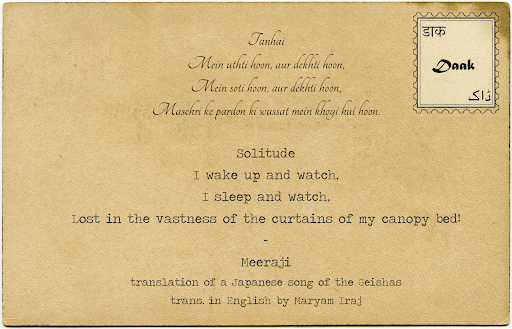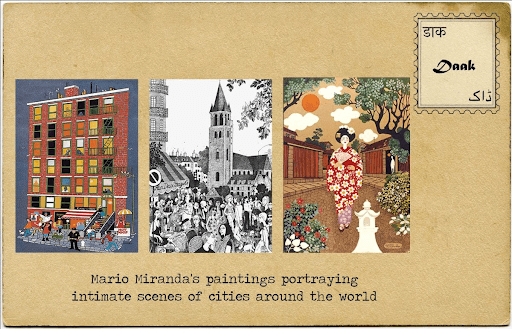Daak: Postcards from a South Asian Attic
Hi there! Who are you and what’s your background?
I’m Onaiza, an anthropologist and my partner, Prachi, runs an educational NGO. We’re both writers and together we run a newsletter called Daak that covers historic South Asian literature and art. We’ve been running it as a weekly newsletter since 2017 — just completed three years this May.

What’s Daak about?
Daak is a collection of unknown stories, artworks and ideas from women and men who have shaped the Indian subcontinent’s cultural heritage. It is an attempt to curate and revive original artistic creations which are deeply profound, characteristically humourous and always, uniquely subcontinental.
What that essentially means is that we cover historic literature and art from the Indian subcontinent. Our focus on this region and the past stems from the simple reason that our home base houses a vast treasure trove which has not yet been fully explored. We are as much readers as writers, and as much consumers as curators of these works.
The word Daak means ‘post’ in Hindi and Urdu. To us, “daak” evokes the lost art of letter-writing: a patient, deliberate and thoughtful exercise in articulating your most compelling thoughts for your reader. This project is our way of sending out letters to all the people who, like us, are looking for something interesting and meaningful to read. It is by intent that our design uses the theme of postcards and stamps.
We aren’t focused on high-brow literature either. We try to uncover non-traditional or radical ideas and viewpoints too. We have covered Gandhi’s letters exhorting Adolf Hitler to avoid war, a humourous poem on cancer by British-born Indian scientist, John Burdon Sanderson Haldane, and one of the feminist sci-fi fiction by Rokeya Sakhawat Hossain.
Much of the literature we cover is in regional languages, therefore we try and break the post-colonial hold that English has over the subcontinent’s youth which is our prime audience. However, a variety of people follow daak, including people in their 50s and 60s and the South Asian diaspora.
What motivated you and your partner to start writing Daak?
We met at a fellowship programme — the Young India Fellowship at Ashoka University, Haryana, in 2013 and forged a friendship based on our mutual love of literature. We began to exchange emails containing pieces of writing, songs and poetry the other enjoyed.
For the longest time we had been complaining that there isn’t a place where we can go and find this kind of content, so we decided to start building something ourselves. We kept the core idea, which is uncovering writers, artists and poets from the Indian subcontinent, but added this theme of letters and postcards, [which] we are both fond of, and that became our central theme.
We both are writers, Prachi is a poet and Onaiza writes prose, so this was a natural addition to our usual writing — giving us discipline and weekly deadlines.

What does the process of writing Daak look like?
We send our newsletter every weekend and take turns writing it. So effectively, we each write a newsletter once a fortnight. It takes about 6 hours to do the compiling and writing and a few more to do the research but that’s spread out. Much of our reading converges towards themes that we can possibly cover on Daak so there is an overlap between leisure and work.
What have you learned through writing Daak?
Newsletter subscribers tend to be interested in depth, they want to read more than what is in the newsletter, so we often provide links. If you’re taking time out to read a newsletter every week, it's almost certain you are more invested. So we try and give our newsletter readers more nuance.
For Instagram and Twitter what works better is nostalgia, humor and like you mentioned, poetry. The success we’ve had with short poems tailored to Instagram has been phenomenal. It could be because amidst the cacophony of brands and noise on Instagram (what with reels and tik tok videos), the slowness and beauty of poetry, especially in regional languages, has a unique charm. The engagement is far greater on social media but our major investment is in research for the newsletter.
Like with the name, so with the design: we tried to keep an element of nostalgia around letter and postcard writing in it. Given that we were digging out what we refer to as ‘treasures from the subcontinent's attic', we thought the metaphor of postcards and lost letters was the most apt description. Hence, the name, and the overall aesthetic — including the weekly mail. Our initial emails were sent under a rather corny subject heading — 'You’ve got Daak!'. So it was very much an evocation of all that we’ve lost in this digital age with regard to slow letter writing.
So it's personally been a wonderful journey, with much learning and many serendipitous discoveries. We’ve picked up social media marketing, design, and just expanded our reading list significantly — and de-colonised it too, we must add.
What’s your favorite part about writing your newsletter?
For both of us, it has been a journey of discovery and the joy of finding a new writer or artist is definitely our favourite part. Also, the feedback from our readers almost always makes us smile. We have a reader in Kenya who responds to every newsletter with a couplet she crafts and we wait for it as it is so heartfelt and lovely. We’ve made many friends through Daak, and the joy of reading with people is undoubtedly almost as profound as all that we read and discover.
Do you have a monetization strategy for Daak?
So many people have told us to monetize the newsletter over the years. Not to say it hasn’t been tempting but it would not fit well with what we’re trying to do. Even if we do monetize it someday, it’ll certainly have a free and open component as well. We’ve been doing it for three years every week and have put out a significant body of work — so, even if we monetize it’ll only be for the content going forth and we don’t plan to paywall any of the existing material.

How do you grow your audience?
We have about 2500 subscribers to the newsletter on email and about a 1000 on WhatsApp. Most of them are dedicated readers, however, our largest fanbase is on social media particularly Instagram, where we have 63,000 followers. They are much more engaged and regularly interact with the content from newsletters that we reshare. Therefore to grow our audience, we normally post on Instagram or Twitter — and more often than not find our subscribers there.
Wow that's a lot of followers! Was Instagram a big focus from the start?
No, actually. Instagram and Facebook were our first social media presence back in 2017 but since we saw a lot of traction on Instagram, we shifted focus to make it our primary social media platform. So we pivoted focus from Facebook to Instagram late 2017, since we saw a lot more engagement there. Methods of engaging there are also way more than other platforms — with questions and polls etc.
What are some of your favorite newsletters, books, and podcasts?
Onaiza: I personally didn't ever read newsletters, even the ones I subscribed to — before we started Daak. Much of my reading was through networks and discovery on social media but increasingly, it has evolved over the years. I subscribe to few but do manage to either read them soon after they come in or bookmark the links and add to a read-later app. So I definitely have become better at reading newsletters over the years — and most of them are by individuals and not by publications.
Prachi: I've subscribed and unsubscribed to many newsletters over the years, but have diligently been reading only 1 or 2 newsletters curated by individuals. The reason for their enduring appeal is a combination of a unique or eccentric writing style and really compelling content. I'm personally biased towards literary or cultural content. Businessy or corporate style newsletters feel too impersonal and politically correct. To me, reading a regular newsletter feels very much like cultivating a friendship — I don't have too many of them, but really like to engage with the ones I do.
Where can readers go to learn more about you and your newsletter?
Readers can find us on Twitter, Instagram, Facebook, or check out our website.



